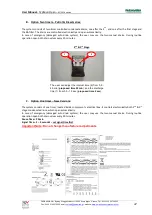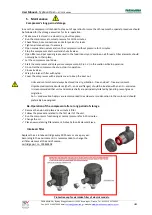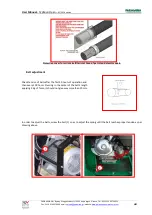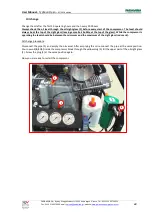
User Manual -
Typhoon Open –
01/2018 edition
.
PARAMINA SA
– Byway Evaggelistrias str. 19300 Aspropirgos, Greece, Tel: 0030 210 5575860-1
Fax: 0030 210 5575868, email:
- website:
www.paramina-compressors.com
6
Basic safety recommendations
The compressor is manufactured following current EU safety regulations.
The compressor is intended
ONLY
for compressing atmospheric air with a content of oxygen (21±1)%.
Use of
any other gas type is not allowed
. The manufacturer is not liable for damages caused by using the unit any
other way than the intended.
Use the compressor after making sure it is in perfect working condition. Any malfunction or failure must be
repaired immediately. Strictly follow the operation and maintenance instructions described in this manual.
Read carefully the instructions in this manual and follow them. Make sure users of the compressor are familiar
with the user instructions of the unit and its proper operation. Make sure they are authorized, trained and
trustworthy individuals. Make sure you are aware of and implement the current legal and all other regulations
pertaining to avoiding accidents and protecting the environment.
During first start or after maintenance, check motor’s direction of rotation. There is an arrow indicating proper
rotation. If the direction is reversed, interchange two of the three phase leads in the switch box
.
Never
change
leads at the
motor
terminal board.
Before starting any work pertaining to maintenance of the compressor, turn off the supply from the mains and
press the Emergency Stop.
If regulations dictate it, use means of individual protection.
Pay attention to labels indicating safety and risk for the unit. Strictly follow them and do not destroy them.
For any change in the operation of the unit, contact immediately the manufacturer.
Any alteration – conversion of the unit without the manufacturer’s prior written consent is not allowed.
Spare parts MUST be genuine – approved by PARAMINA SA.
Get accustomed to the position and use of fire extinguishing equipment that must be near the compressors.
Instructions for safe operation - risks
Check the unit on the inside and outside on a daily basis in order to make sure it is in good working condition.
Do not start the operation of the unit if you do not ensure your own safety.
Before you operate the compressor, make sure that requirements are met for the safe and smooth operation of
the unit.
Floor must be even. Adjust the anti vibration pads, so as the unit is in horizontal position and shocks are
minimized.
Place the compressor in a well-ventilated area. Make sure that the intake air for the compressor is clean and
cool.
Prevent the hot cooling air from recirculating to the cooling air intake.
Make sure that foreign objects
cannot get into the compressor with the intake air.
Make sure that the intake air does not contain any smells,
fuel or fumes, explosive or inflammable gases or harmful substances
.
Units with petrol engine or diesel engine should not be used indoors.
Assign the unit (if it uses petrol engine or diesel engine) towards the
direction of the wind, so as fumes are getting away. In this case, use the
input hose of the inlet air filter in such a way, that fumes are avoided to
enter the compressor.
Keep the compressor away from flammable material. Do not smoke when opening the fuel tank.
If any malfunction of the unit occurs, stop immediately its operation and check – fix the problem.
Before any maintenance or repair works, inform the users.
When replacing heavy-weight components, strap them carefully on the proper lift truck. Never walk under such
components when they are lifted.
Before any maintenance works, clean the area from out-of-use material, oils, fuel or other liquids from the unit.
Do not use corrosive materials. If you clean the unit by water or steam, make sure that neither (water nor
steam) comes close to the electric motor or the electric system and ensure that they will not enter open hoses.
For cleaning, use lint-free cloth.
After cleaning or repairing the unit, check all hoses for leaks, loose connections, wear or damages. Tight again
all connections and recheck every maintained safety device.
Ensure safe and environmental
friendly disposal of consumable materials and old spare parts.







































